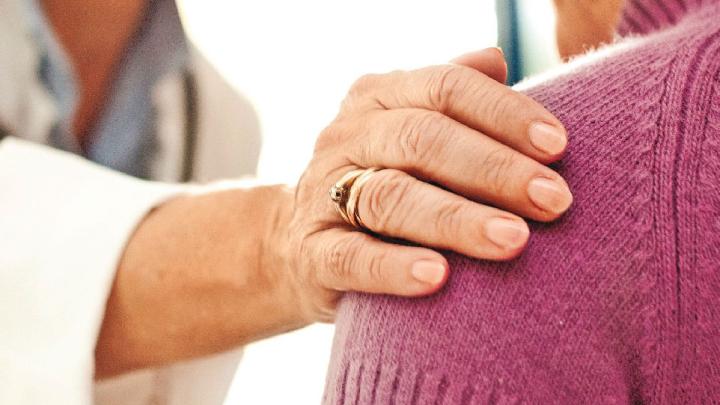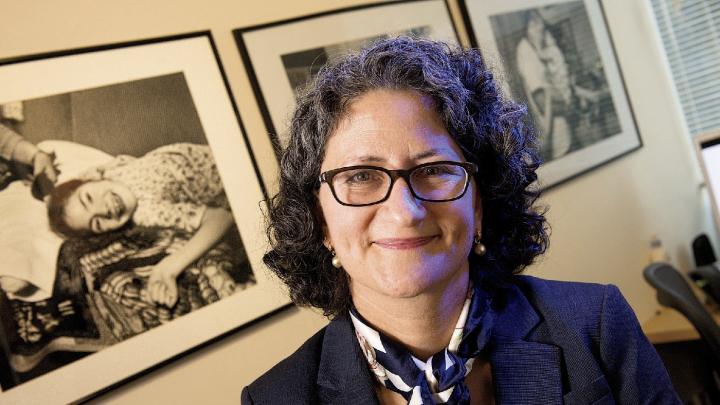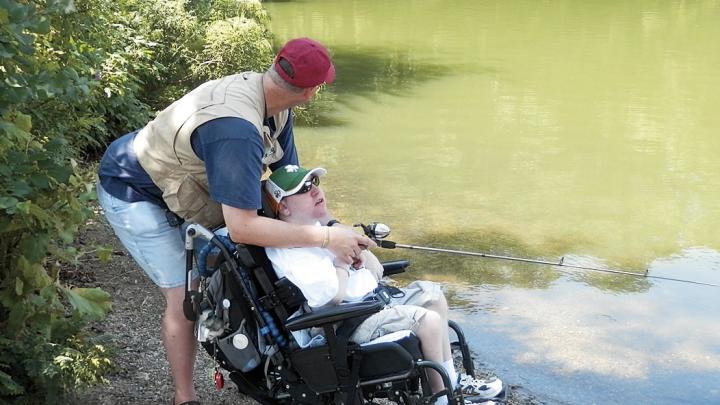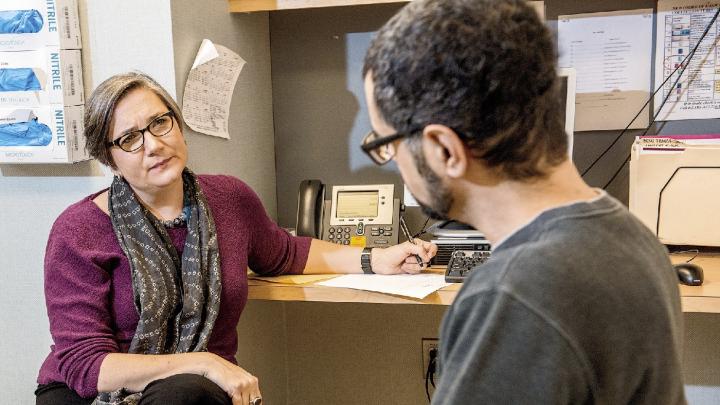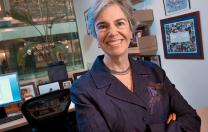Eric Buck’s life turned upside down in the spring of 2014, after doctors diagnosed the lump in his right buttock as a fast-growing sarcoma. Five weeks of chemotherapy and radiation preceded surgery that left a 15-inch incision and significant muscle loss. Though his tumor was gone, Buck experienced nerve pain, insomnia, anxiety, and spiritual distress. He remembers hitting a low point in the fall, “a period of time when life just was rotten.” The 48-year-old Somerville, Massachusetts, resident was back teaching philosophy at several local colleges, and recalls, “I was coming home almost cross-eyed with exhaustion, not being able to get any good sleep at night, and I was crying at the drop of a hat. I needed somebody who could take my pain and suffering in hand and make that the focus of my treatment.”
That somebody was physician Vicki Jackson, assistant professor of medicine and chief of palliative care at Massachusetts General Hospital (MGH). Buck had started working with Jackson before surgery, on the advice of his oncologist, and continued for several months until he felt better. Jackson tried various combinations of medications to ease his symptoms and adjusted them when Buck—who is sensitive to the effects of drugs—had nightmares, jitters, or other bad reactions. She referred him to specialists to address his emotional and spiritual struggles, like his fear about the cancer coming back. The two communicated by phone, e-mail, and in person.
Throughout his ordeal, Buck had a strong network of family and friends, including his wife, Betti. “But Vicki, she’s the real knowledgeable friend,” he says. “She becomes an advocate and tells you things like, ‘You don’t need to suffer. We can moderate your pain.’ I’m still grateful for Vicki’s help, and for what the whole world of palliative care does.”
“Palliative” means “soothing” or “relieving,” and palliative-care teams—which may include specially trained physicians, nurses, social workers, chaplains, and others—provide an added layer of support for people facing serious health problems and for their families. Working with the primary medical providers, the teams’ goal is to improve patients’ quality of life and well-being. As a palliative-care clinician, “My job is to try to help people with serious illness live as well as they can, for as long as they can,” says Jackson, who also teaches and conducts research on palliative medicine, a relatively new specialty (see the sidebar, “From Specialty to Shortage”).
Palliative care is often confused with hospice. That’s understandable, because it’s an important component of hospice care. But while hospice offers comfort during the last months of life, palliative care can be given at any point in a serious illness—and alongside curative treatment. It is appropriate for any age or diagnosis, from cancer to dementia to heart, kidney, or liver disease. Interdisciplinary by nature, palliative-care teams focus on managing symptoms and stresses and helping patients and families make informed decisions that reflect what’s most important to them. At Beth Israel Deaconess Medical Center (BIDMC) in Boston, palliative care also includes a staff harpist who plays relaxing and therapeutic music around the hospital, and a cluster of volunteers who spend time at the bedside of sick patients who don’t have visitors. “Most people who are seriously ill are afraid of being alone,” says Annie Banks, senior social worker with the BIDMC palliative-care service. In palliative care, the emphasis is on the person’s needs, not the disease.
Abundant evidence suggests that palliative care enhances quality of life, reduces healthcare costs, and even helps people live longer. Recognizing these benefits, the Institute of Medicine has called for sweeping changes to strengthen both palliative and end-of-life care nationally. In a report released in September, the institute said everyone should have access to high-quality, affordable palliative and hospice care when and where they need it.
Palliative care can be delivered in hospitals, homes, clinics, and nursing facilities, and health insurance typically covers some services. It usually requires a referral, so patients who want to try palliation should discuss it with their primary doctor, advises professor of medicine Janet Abrahm, a palliative-medicine physician with Dana-Farber/Brigham and Women’s Cancer Center. “Patients shouldn’t worry that asking for palliative care will mean to the physician that they’re ‘giving up,’” says Abrahm, author of A Physician’s Guide to Pain and Symptom Management in Cancer Patients. “Palliative care is an extra layer of care, in addition to what they’re getting from their primary team.”
A Beginning
It’s a snowy December evening, and 22-year-old Tim Stevens is lying comfortably in bed, smiling broadly and turning his head toward his mom’s voice. “Hey, bud. That was a good dinner, huh?” Ellen Waddill says after giving him a meal of canned formula and various medications through a feeding tube. Stevens has cerebral palsy from a lack of oxygen during birth. He doesn’t speak and has limited movement and vision, but he expresses himself with his bright eyes, smile, and occasional vocal sounds.
“He’s such a great kid. His personality shines through even though he doesn’t talk,” Waddill remarks as she strokes his hands, which are folded up against his chest from tight muscles. Stevens’s neurological disorder hasn’t kept him from typical 20-something activities, like hanging out with friends, listening to the radio, and rooting for sports teams. With assistance from his stepfather, he even goes fishing. The family moved his bed and medical equipment—machines, monitors, wheelchair, and the like—to the dining room a few years ago so Stevens could be at the heart of their home in Tewksbury, Massachusetts. “He has touched so many people’s lives,” his mother says. “He’s the light of my life. He’s amazing.”
Stevens is healthy on this winter night, but Waddill remembers when he was 16 and in and out of Boston Children’s Hospital for various respiratory infections. “He had a really bad year,” she recalls. One of his doctors suggested bringing in pediatric palliative care to address the family’s worries and plan for Stevens’s future. Waddill hesitated for months but finally agreed. “I didn’t really know what it was about,” she recalls. “I thought it might have meant we’re giving up, this is the end. But really it was the beginning. It was the beginning of some great conversations and a great relationship with the PACT team.”
The Pediatric Advanced Care Team (PACT), a joint program of Children’s and Dana-Farber Cancer Institute, began that relationship with a home visit by team founder and director Joanne Wolfe, associate professor of pediatrics, and other colleagues. PACT clinicians—including doctors, nurses, and social workers—help promote healing, comfort, and quality of life for children with life-threatening health problems. Pediatric palliative care resembles its adult counterpart but places special emphasis on the family and community, “because there’s a ripple effect whenever there’s a child with a serious illness,” says Wolfe, who leads pediatric palliative care services at both institutions.
Wolfe became interested in palliative medicine during her training in pediatric hematology and oncology at Harvard, when she began to study the experiences of bereaved parents whose children had died from cancer. She discovered that many children had suffered substantially, and she knew it didn’t have to be that way. Wolfe and a handful of Dana-Farber clinicians then spent a year consulting with national leaders in palliative and end-of-life care, and PACT emerged in 1997 as one of the country’s first pediatric palliative-care programs. The field was so new that when PACT members walked onto a floor at Children’s, some suspicious staffers dubbed them the “grim reapers.”
Now a model for similar efforts, PACT cares for about 750 patients annually, ranging from babies with heart disease, neurological conditions, or cancer to adult survivors of childhood illnesses such as cystic fibrosis. Many of its patients live for a relatively long time, but the team also provides bereavement support for families who’ve lost a child. One of its key roles is to advocate with other clinicians when a family wishes to try—or to avoid—certain drugs or procedures. Says Wolfe, “We help the family push the envelope of what’s most important to them.”
Keeping her son at home is a priority for Waddill, who works at a center that serves children with special needs. During the past six years, PACT has been especially valuable in helping Waddill and Tim’s father, Lee Stevens, agree on what to do if the young man’s health deteriorates. “We’ve talked about what we would want for Tim. We never want him to suffer,” Waddill says. Knowing the family has a plan in place for the future “gives me a peace of mind and really helps me concentrate on Tim.”
Helping Patients Cope
Like many Americans, Bill and Judy Jenkins of Canton, Massachusetts, had associated palliative care with the end of life. But shortly after Bill was diagnosed with pancreatic cancer in the fall of 2011, he was invited to join a clinical study at MGH exploring the value of giving patients palliative care early on—to complement their regular treatment for advanced lung and gastrointestinal cancers. “We said sure,” recalls Bill, 72.
They began talking regularly with Vicki Jackson, often during Bill’s long chemotherapy sessions, and have laughed together, cried together, and discussed how to lessen side effects from his disease and treatment. Jackson has prescribed medications, for example, to boost his energy, prevent pain, and help with digestion. Although their primary team at MGH is excellent, “Vicki’s the one we call when we don’t know what to do, when we have symptoms we don’t know how to handle,” Judy says. “She is completely attuned to how we’re feeling. She has been an incredible comfort. Because a lot of the time you feel very alone.”
The couple has faced moments of fear and despair during Bill’s 65-plus chemotherapy and radiation sessions and two major surgeries, according to Judy. They both know he will not recover, and Bill has chosen what color shirt he will wear at his funeral. But aided by Jackson’s realistic yet uplifting approach, the Jenkinses have been living with cancer as fully as possible. Since his diagnosis more than three years ago, Bill, a semi-retired real-estate developer, has been able to travel and spend time with family and friends, including a November trip to California to see two of their grandchildren perform in The Sound of Music. As Bill puts it, “Vicki has been very good about helping us live for today and enjoy each day that we have. She’s been a tremendous help to us on this journey.”
The clinical trial Bill joined is a larger follow-up to the landmark study MGH investigators conducted several years ago that revealed multiple benefits of early palliative care. That research, led by oncologist Jennifer Temel, associate professor of medicine, involved 151 patients with metastatic lung cancer. Half received standard treatment, while half also saw a palliative-care clinician at least monthly. “The meetings weren’t scripted,” Temel explains. “If the patient said, ‘I’m in so much pain,’ they talked about pain. If patient said, ‘Am I dying?’ they went there.”
According to findings published in the New England Journal of Medicine in 2010, patients in the palliative-care group had better quality of life, less depression, and less aggressive end-of-life care. Not only that, they lived almost three months longer, on average, than the lung-cancer patients who received standard care only. That last finding went viral. Looking back, Temel says, “The survival benefit certainly got a lot of attention, but to me the salient part of the results is that we made people feel better. Because this population is really suffering.”
The Conversation
At the core of palliative medicine is a conversation, or series of conversations, about a patient’s hopes, values, and preferences for care. “Our main procedure in palliative care is difficult communication,” notes Susan Block, a professor of psychiatry and medicine based at Dana-Farber. Palliative specialists help patients and families weigh the benefits and drawbacks of various treatments, navigating a high-tech medical culture geared toward procedures and therapies that may hold the promise of saving and extending lives. Some patients want the “full-court press,” while others may prefer comfort-focused care, or something in between.
Block and other colleagues believe every doctor who sees seriously ill patients should possess the skills to lead these conversations—especially when a patient’s life expectancy is short. But research led by Dana-Farber investigators in recent years shows that between one-quarter and two-thirds of patients with advanced cancer don’t have such talks with their physicians, and when they do occur, the discussions often take place in the hospital just a month before death. “By a month before you die, you’re pretty sick [and] the family is overwhelmed,” says Block. “This is a terrible way to do things.”
Atul Gawande, a surgeon at Brigham and Women’s Hospital (BWH), realized some time ago that he wasn’t effective in communicating with patients facing unfixable problems, and that medical school had taught very little about aging and dying. So Gawande, who is also a staff writer for The New Yorker (see “The Unlikely Writer,” September-October 2009), started gathering answers for an article and eventual book. Among the more than 200 patients, family members, and practitioners he interviewed was Block, an internationally known expert in palliative care, who shared her mental checklist of questions for terminally ill patients, including: What is your understanding of your condition? What are your fears and worries about what lies ahead? How do you want to spend your time if your health worsens? What kinds of tradeoffs are you willing to make in the course of care? Who do you want to make decisions for you if you can’t?
“I ended up carrying the New Yorker piece into my conversations with patients so I could use that little paragraph [with the five questions],” recalls Gawande, now Thier professor of surgery at Harvard Medical School and professor in the department of health policy and management at Harvard T.H. Chan School of Public Health (HSPH). “I found out that other physicians were doing the same thing.” The original essay is folded into Being Mortal: Medicine and What Matters in the End, a bestseller published last October that makes a compelling case for improving the treatment of elderly and dying individuals. “Palliative care and geriatric doctors treat the [end of life] conversation as something that takes art and skill and practice,” Gawande says. “It boils down to this basic set of precepts: People have priorities in their lives besides just living longer. We don’t know what they are. The most reliable way to find out is to ask—and we don’t ask. We do not reward clinicians for taking the time to have conversations. I get paid well to do the operation and little to have these kinds of conversations and to do them well.”
Gawande and Block are now collaborating to scale up the checklist. Their initiative, the Serious Illness Care Program (a project of Ariadne Labs, a joint center at BWH and HSPH that Gawande launched to discover and spread scalable solutions for improving healthcare), is developing training, educational materials, and processes to increase meaningful end-of-life discussions. For example, the training gives physicians practice with key skills such as discussing a patient’s prognosis, allowing silence, and refraining from speaking more than half the time. Says Block, “The usual serious illness conversation in the hospital goes something like, ‘We have to talk to you about resuscitation. If your heart stops, do you want us to restart it?’ This is a different approach.”
Block and colleagues are evaluating the communication tools in several medical settings, including a randomized trial at Dana-Farber, and have plans to expand them nationally. Early results are promising, with patients’ anxiety levels falling after these exchanges, and most clinicians finding them helpful.
Across town, MGH hospitalist Angelo Volandes, assistant professor of medicine, is waging his own campaign to encourage frank, open discussions between doctors and their gravely ill patients. In his new book, The Conversation: A Revolutionary Plan for End-of-Life Care, he argues that too many Americans suffer needlessly at the end, tethered to machines and in pain, because their doctors haven’t accurately described various procedures or asked how they want to live their remaining time. To give patients a more clear-eyed picture and spur these conversations, Volandes and colleagues began developing a library of short medical videos, starting with cardiopulmonary resuscitation, that are available through his nonprofit Advance Care Planning Decisions.
Volandes’s passion for these issues began unexpectedly when he was an undergraduate and took a job cooking meals for a retired professor and his wife, who was dying from emphysema. One afternoon at their home, as he recounts in the book, Volandes and the professor watched helplessly as the woman gasped for air and began turning blue. She eventually stopped choking, but the scene haunted Volandes and propelled him to medical school, hoping, he writes, “to understand what it meant for patients to be sick and dying, and to prepare them for their journey.”
A Child’s Name on Every Stone
Four tall glass vases stand in a corner of Joanne Wolfe’s office at Dana-Farber, each holding dozens of earth-colored stones bearing a first name: Jacob, Veronica, Xavier, Brenya, Joey. The tribute stones are part of an annual ritual by the PACT team. “We get together and write on a stone the name of each patient we cared for who died that year,” says Wolfe. “We reflect on that child and family and share an anecdote that helps us celebrate the life of that child.”
Delivering palliative care requires skill, compassion, a good listening ear, and a level of comfort with topics most people would rather avoid. “This work is not a piece of cake,” says Banks, the social worker at BIDMC. Palliative-care specialists support families through daunting health challenges. They witness vulnerability and sadness, along with remarkable tenderness, resilience, and healing.
“You get to know people at a very intimate time,” attests Connie Dahlin ’82, who spent many years after college providing hospice and palliative care in Boston and now focuses on palliative-care education and program development for nursing and other disciplines, both locally and nationally. She also cares for patients at North Shore Medical Center in Salem, Massachusetts, and describes a young truck driver who was hospitalized with late-stage lung cancer. “The moment that will stay with me forever is holding this wonderful young man on one side, and his mother holding him on the other, as he died in our arms,” Dahlin says. “Being a mother myself, it was heartbreaking. We held him for a while. Then I walked out of the room and started crying. Some of the younger nurses were like, ‘Why are you crying? You do this all the time.’ Yes, I do this all the time, but these are poignant moments. For me, if I didn’t cry, then I should leave the profession. Because how could it be more poignant than that?” “Some of the younger nurses were like, ‘Why are you crying? For me, if I didn’t cry, then I should leave the profession.”
Palliative caregivers say this work puts their personal priorities, like spending time with children and spouses, into sharper focus. Susan Block knows this well, as she has been supporting her husband and long-time collaborator, J. Andrew Billings, through his grueling treatment for lymphoma. (Billings, an associate professor of medicine, founded MGH’s palliative-care program.) “My top priority is to have as much time as possible to be with my husband,” Block said last autumn. Down the road, “I don’t want to feel like I wish I had made a different set of choices about my time.”
Says Vicki Jackson, “This work can be very grounding, because the life lessons we learn are fairly simple: Tell people you love them. Try to be good to other humans. And try to keep things in perspective. I love the field. I love my job. I love our division. Delivering palliative care is hard work, but it is extremely rewarding.”
